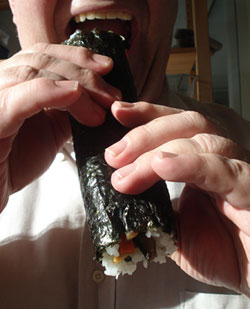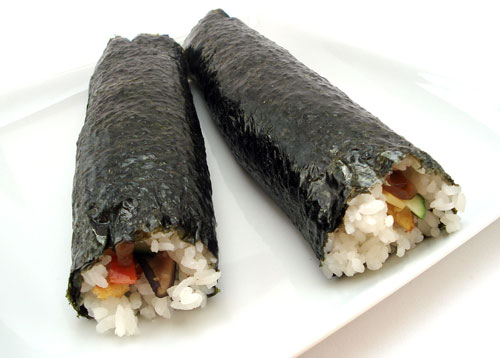
This month's Japan Times article is about the traditions and superstitions surrounding Setsubun, which is coming up on February 3rd.
Filed under:
japanese holidays japan traditions writing elsewhere beans japan times
Pondering a little about religious and cultural traditions, and food.
Filed under:
philosophy japan traditions
 This year, setsubun no hi (節分の日) falls on the 3rd of February (some years it's on the 4th). It marks the start of the spring season or risshun (立春) in Japan according to the old lunar calendar. It's not an official national holiday, but it is celebrated in ways all meant to drive away bad luck and bring in new, good luck. Most of the traditional rituals revolve around beans, because beans are considered to be very lucky. But there is another way of celebrating setsubun no hi, and that's with a big, long, uncut sushi roll called ehou-maki.
This year, setsubun no hi (節分の日) falls on the 3rd of February (some years it's on the 4th). It marks the start of the spring season or risshun (立春) in Japan according to the old lunar calendar. It's not an official national holiday, but it is celebrated in ways all meant to drive away bad luck and bring in new, good luck. Most of the traditional rituals revolve around beans, because beans are considered to be very lucky. But there is another way of celebrating setsubun no hi, and that's with a big, long, uncut sushi roll called ehou-maki.
I grew up in and around the Kanto region, which is the area around Tokyo, so I didn't know about ehou-maki ((恵方巻き)growing up, because it's a Kansai region (the area around Osaka and Kyoto) custom for setsubun no hi. Nowadays though the ehou-maki tradition has become popular nationwide. They are sold everywhere, especially at convenience stores, who take this as an opportunity to get people to celebrate, buy and eat in that awkward gap in between New Year's feasting and Valentine's Day chocolate gorging.
[Edit: ehou is pronounced eh-hoe by the way, not ee-h
aw.]
So, what makes an ehou-maki different from a regular sushi roll? There are basically three rules:
- It must contain seven ingredients, because seven is a lucky number.
- It must not be cut, because it might cut (off) your luck.
- You have to eat it while facing the lucky direction, which changes every year! This year's lucky directly is hinoe (丙 (ひのえ)), which is a little bit to the south of south-south-east on a regular compass. If you can read kanji, this page has a good chart.
- Finally, you must eat the whole roll in total silence.
A seven-ingredient sushi roll is basically a futomaki, or fat sushi roll, and that is what the directions are for. I've suggested several filling variations.

Last year, the Superbowl fell right on Setsubun no hi, so there's a New York-Boston filling combo below. This year, I guess the Cardinals were out of luck, ehou-maki wise. (What would have been a good Pittsburgh-themed sushi roll filling?)
You can of course order a regular futomaki from your favorite sushi takeout, and ask them to put in seven ingredients and to not cut it. Then on Sunday, face the right away, and solemnly eat your roll in total silence.
Filed under:
japanese party food sushi traditions